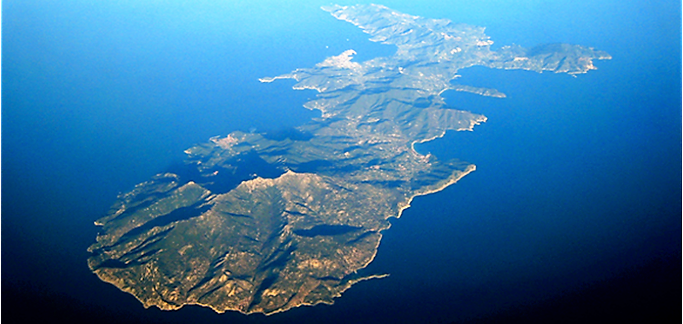Baratti, Populonia e Isola d’Elba-and english translation

Baratti, Populonia e Isola d’Elba
A 35 km da Follonica verso Piombino, torniamo indietro nel tempo di circa 2600 anni. Ci troviamo nello splendido Parco di Baratti e Populonia dove si possono apprezzare le opere e le testimonianze della vita degli Etruschi. Incantevole anche la vista dell’insenatura del Golfo di Baratti che vanta un porto turistico. L’Anfora d’argento ritrovata nel mare davanti alla località Etrusca e attribuibile al IV sec. a.C., si può ammirare nel Museo archeologico di Populonia, a Piombino.
Dalla città famosa anche per le sue acciaierie, ci si imbarca per arrivare sull’Isola d’Elba.
Piombino e Portoferraio distano un’ora di traversata, mentre sempre dalla terraferma a Rio Marina occorrono 45 minuti. Volendo si può attraccare per poi sbarcare a Porto Azzurro in un’ora e 15 minuti. Da queste tre località si può procedere visitando l’Isola con escursioni nell’entroterra o sulla costa. Famosa per essere stata la sede dell’esilio di Napoleone Bonaparte. Non tutti sanno che il nome Elba deriva da Ilva, così chiamata in antichità dagli Ilvati che abitavano l’Isola ricca di giacimenti di ferro. A Follonica è tutt’ora presente, ma dismessa da tempo, la prima fonderia di ghisa nata in Europa, che appunto si chiama Ilva.
Oltre ai luoghi in cui l’Empereur francese passò gli ultimi 10 mesi della sua vita a Portoferraio in Villa dei Mulini e Villa San Martino, si possono ammirare resti di antiche ville romane, la Torre di San Giovanni, la Fortezza di Montemarciale e quella del Volterraio. Ideale per gli appassionati subacquei, anche quella di Baratti-Populonia-Elba è un’escursione da non perdere. Visitando l’antica Ilva si possono notare le famose targhe apposte sulle case che citano il passaggio o un soggiorno di Napoleone. Tranne che in una dove il goliardico, ma sincero autore ha scritto: “Qui Napoleone non c’è mai stato”, o cosa analoga. La citazione è a memoria.
Trovandoci sull’Isola d’Elba è impossibile non degustare il tipico vino Aleatico. Si può intuire perché sia sempre stato definito “Il Nettare degli dèi”.
Immagine dal web
Baratti, Populonia and the Island of Elba
Just 35 kilometers from Follonica in the direction of Piombino, we travel back in time some 2,600 years. We are in the magnificent Park of Baratti and Populonia, where visitors can appreciate the legacy and craftsmanship of the ancient Etruscan civilization. The natural beauty of the Gulf of Baratti, with its charming marina, is truly captivating. One of its most precious archaeological finds—the silver amphora, discovered in the sea off this ancient Etruscan site and dating back to the 4th century BC—can now be admired at the Archaeological Museum of Populonia in Piombino.
From this coastal town—known not only for its ancient roots but also for its steel industry—you can embark on a journey to the Island of Elba. The ferry crossing from Piombino to Portoferraio takes about an hour, while the route to Rio Marina takes around 45 minutes. If you choose to dock at Porto Azzurro, the trip lasts about an hour and fifteen minutes. From each of these ports, it is possible to explore the island by heading inland or following the scenic coastline.
Elba is most famously remembered as the place of exile for Napoleon Bonaparte, but not everyone knows that the name “Elba” derives from Ilva, the name given in ancient times by the Ilvati, the island’s original inhabitants, who settled in this iron-rich land. In fact, the first cast-iron foundry in Europe—later named Ilva—was established in Follonica and still stands there, though it has long since ceased production.
In addition to the Villa dei Mulini and Villa San Martino, where the French emperor spent the final ten months of his life, the island is home to numerous Roman ruins, the Tower of San Giovanni, the Fortress of Montemarciale, and the Volterraio Fortress. For diving enthusiasts and history lovers alike, the Baratti–Populonia–Elba route offers an unforgettable experience.
When visiting the ancient Ilva, you’ll also come across plaques on buildings marking places where Napoleon stayed or passed through. With a touch of Tuscan humor, one plaque reads (this from memory): “Napoleon never set foot here.” A local’s honest and tongue-in-cheek way of breaking the pattern.
And if you find yourself on Elba, you simply can’t miss the chance to taste a glass of Aleatico, the island’s iconic wine—long known as “the nectar of the gods.”
Image: from the web
arezzo filastrocche firenze i miei libri maremma maurizio de cicco poesie poeticando roma siena


